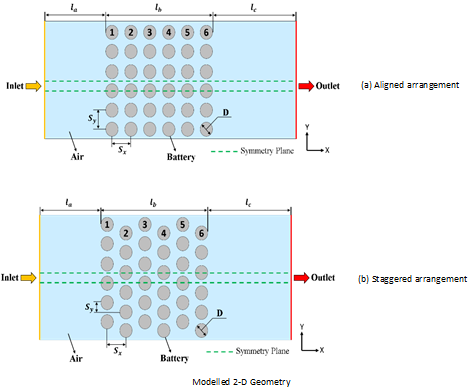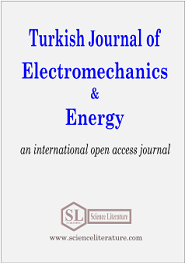
Heat transfer and thermal management of lithium-ion battery pack system with forced air convection
Abstract
Studies on battery cooling systems gain momentum every new year due to their limited operating temperature range. As lithium-ion batteries are one of the critical components of electric vehicles, researchers have recently focused on them. A two-dimensional analysis of a battery pack has been carried out in the current study. A hydrodynamic and thermal study was conducted for an air-cooled 6x6 battery pack (36 Lithium-ion 26650, LiFePO4 batteries in total) system. The system was analyzed using the ANSYS / FLUENT software for aligned and staggered battery arrangements in steady-state conditions. The system's temperature distribution and pressure drop were scrutinized for constant volumetric flow rates of , , and for the aligned order. Same analyses were performed for the staggered order, with the help of keeping the mass flow rate constant. Numerical analyses were also performed for the discharge conditions of the batteries. Uniform and constant heat generation were assumed for the batteries during the discharge process. Heat generation was attributed as 1.43 W and 2.75 W per battery, corresponding to 2C and 3C discharge rates, respectively. The effect of battery arrangement and the air mean velocity on the temperature distribution and the total pressure drop in the system were inspected.
Full Text:
PDFReferences
Y. Deng et al., "Effects of different coolants and cooling strategies on the cooling performance of the power lithium-ion battery system: A review," Appl. Therm. Eng., 142 (June), pp. 10–29, 2018.
A.A. Pesaran, "Battery thermal models for hybrid vehicle simulations, " J. Power Sources, vol.110, pp. 378-382, 2002.
N. Sato, "Thermal behavior analysis of lithium-ion batteries for electric and hybrid vehicles," J. Power Sources, 99(1–2), pp. 70–77, 2001.
P. Ramadass, B. Haran, R. White, B. N. Popov, "Capacity fade of sony 18650 cells cycled at elevated temperatures Part I. Cycling performance," J. Power Sources, vol. 112, pp. 606–613, 2002.
R. Sabbah, R. Kizilel, J. R. Selman, and S. Al-Hallaj, “Active (air-cooled) vs. passive (phase change material) thermal management of high power lithium-ion packs: Limitation of temperature rise and uniformity of temperature distribution,” J. Power Sources, 182(2), pp. 630–638, 2008.
X. Li, F. He, L. Ma, "Thermal management of cylindrical batteries investigated using wind tunnel testing and computational fluid dynamics simulation, " J. Power Sources, vol.238, pp. 395-402, 2013.
H. Park, "A design of airflow configuration for cooling lithium-ion battery in hybrid electric vehicles," J. Power Sources, vol. 239, pp. 30–36, 2013.
N. Yang, X. Zhang, G. Li, and D. Hua, “Assessment of the forced air-cooling performance for cylindrical lithium-ion battery packs: A comparative analysis between aligned and staggered cell arrangements,” Appl. Therm. Eng., vol. 80, pp. 55–65, 2015.
R. Mahamud and C. Park, "Reciprocating airflow for Li-ion battery thermal management to improve temperature uniformity," J. Power Sources, 196(13), pp. 5685–5696, 2011.
F. He, H. Wang, L. Ma, "Experimental demonstration of active thermal control of a battery module consisting of multiple Li-ion cells, " Int. J. Heat. Mass Tran vol. 91, pp. 631-639, 2015.
Z. Lu et al., “Parametric study of forced air cooling strategy for lithium-ion battery pack with staggered arrangement,” Appl. Therm. Eng., 136 (February), pp. 28–40, 2018.
A. Lazrak, J. F. Fourmigué, and J. F. Robin, “An innovative practical battery thermal management system based on phase change materials: Numerical and experimental investigations,” Appl. Therm. Eng., vol. 128, pp. 20–32, 2018.
C. V. Hémery, F. Pra, J. F. Robin, and P. Marty, “Experimental performances of a battery thermal management system using a phase change material,” J. Power Sources, vol. 270, pp. 349–358, 2014.
Zhao, J., Rao, Z., Huo, Y., Liu, X. & Li, Y., "Thermal Management of Cylindrical Power Battery Module for Extending The Life of New Energy Electric Vehicles," Applied Thermal Engineering, vol. 85, pp. 33-43, 2015.
URN: https://sloi.org/urn:sl:tjoee61184
Copyright (c) 2021 Turkish Journal of Electromechanics and Energy

This work is licensed under a Creative Commons Attribution-NonCommercial 4.0 International License.

 Indexed in:
Indexed in:
















